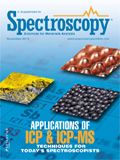Isotope Selection for ICP-MS Quantitative Analysis
Spectroscopy recently spoke with Frank A. Kero, an analytical applications specialist with Biotage, about his research with ICP-MS.
Spectroscopy recently spoke with Frank A. Kero, an analytical applications specialist with Biotage, about his research with ICP-MS.
In a recent paper (1), you discussed studies in elemental isotope selection for quantitative analysis by ICP-MS with a helium collision cell. Why did you select selenium as your analyte of interest?
Selenium has recently found favor in regulatory programs as a result of recent advances in interdisciplinary research related to biomonitoring, environmental studies, and issues related to public health. I selected selenium for this research as it seems the ideal candidate for exploring the fundamentals of quantitation with ICP-MS because of the detailed isotopic envelope found in nature. I found it interesting to observe how significant isotope selection is in the determination of a quantitative result. Isotope selection provides an additional measure of selectivity since by definition, isobaric interferences are mass dependent.
How does the inclusion of a collision cell improve the selectivity of an ICP-MS measurement?
The collision cell removes isobaric interferences that can bias the result of a quantitative measurement. Depending on the optimization strategy, the presence of a collision cell has proven effective in mitigating this issue, but it is not guaranteed protection. The separation of analyte and interference is based on a kinetic energy discrimination voltage applied after a series of controlled inelastic collisions through the path of the collision cell. It is a bit of an art, and it is possible for the analyst to fail. In this work, this possibility was illustrated to raise awareness of this issue.
It should also be noted that helium is not the only option for collision gases with ICP-MS. There is a strong presence in the literature of groups that use reactive gases (for example, H2 or O2). Reactive gases function to shift the mass of the interfering species. Cold plasma applications (without the collision cell) run analogous to this strategy where the analyte of interest is measured as an oxide (that is, mass shift analyte).
You mentioned that further evaluation should include a study of the concentration dependence of the interfering ions on collision cell performance. What results would you expect from such a study?
The kinetic energy discrimination separation mechanism is based on probability and statistics. As the number of interfering ions increases, the population of the ions of interest remains a fixed quantity. It follows that the probability of discriminating the ions of interest decreases with increasing concentration of isobaric interferences. This concentration limit should be determined and one would expect this limit to be isotope dependent.
Reference
(1) F. Kero, L.R. Moore, and J. Malson, Spectroscopy 27(12), 24–29 (2012).

High-Speed Laser MS for Precise, Prep-Free Environmental Particle Tracking
April 21st 2025Scientists at Oak Ridge National Laboratory have demonstrated that a fast, laser-based mass spectrometry method—LA-ICP-TOF-MS—can accurately detect and identify airborne environmental particles, including toxic metal particles like ruthenium, without the need for complex sample preparation. The work offers a breakthrough in rapid, high-resolution analysis of environmental pollutants.
Trending on Spectroscopy: The Top Content of 2024
December 30th 2024In 2024, we launched multiple content series, covered major conferences, presented two awards, and continued our monthly Analytically Speaking episodes. Below, you'll find a selection of the most popular content from Spectroscopy over the past year.